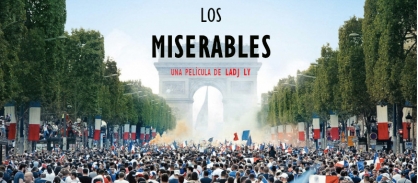The Miserables

Victor Hugo published his novel Les Miserables in 1862. It places it in Montfermeil, a suburb to the east of Paris, within the Saint-Dennis area. The story of this film happens right there, more than 150 years later. The revolutionary teenager Gavroche now has a black face and his demands for freedom and justice are even more vivid.
Frenchman Ladj Ly's film begins with the 2018 World Cup final, where the teams from France and Croatia faced off, and the French were the world soccer champions. The scenes show thousands of youngsters in Paris, with faces of so many races, united in the common brotherhood that soccer offers in such an ephemeral way. Immediately, the return to the poor suburbs, to the wandering in the streets, to the gangs, to the learning of survival.
The first protagonists that appear in the film are three policemen from the crime brigade, assigned precisely to the neighborhood of Montfermeil: Chris is the tough boss; Gwada, the obedient young companion; Stéphane, the new policeman recently arrived in Paris. They represent official law and order; but there are other characters in the neighborhood who also carry their own law and organization, with their own leaders, among African groups, Muslims, drug traffickers, and with the demarcation of public spaces, the control of their interests, the conflict and violence management, indoctrination and proselytizing. In the midst of this reality, the narration will focus - little by little - on children and adolescents as learners of adults and as future protagonists. A cinematographic narration that seems more like documentary cinema, with an excellent handling of the camera -especially the shooting areas- that is getting between the alleys, the multi-family, and the various groups, in an always latent tension and about to explode.
The trigger will be something very simple in appearance, and more because it is in the hands of adolescents: the theft of a lion cub that has escaped from a gypsy circus and a drone that flies over the neighborhood, commanded by an Afro boy. The police brigade will be challenged to act to stop the conflict or to exacerbate it; This second route will be the one they will take, almost without knowing how, almost to justify that they have official power. But the diverse positions of the three police officers regarding the situation will short-circuit each other, especially in the face of the ethical claim of the upstart Stéphane. Then, the tension will grow among the various groups in the neighborhood, and will also catch the tension of the spectators, and the young teenagers will sadly become the protagonists of the unstoppable channel that will take the social conflict.
The new "sons of the country", these violated kids, take on the final verses of La Marseillaise: "We will enter the quarry when our elders are no longer there; we will find its ashes and the trace of its virtues. Less jealous of surviving them than of sharing their grave, we will have the sublime pride of avenging or following them. " Take revenge or follow the example of adults: both unfortunate choices.
These youngsters, French citizens but second-rate, displaced from social benefits and education, apprentices of violence and crime, survivors of poverty, miserable, repressed and humiliated by adults - whatever group - They now become authors of the story script and the climax of the film. The director manages an extraordinary final sequence, in which two looks and two weapons have to face each other: the police and the teenager, each one ready to shoot; and a third glance: that of the drone boy, now a witness through the viewfinder of the closed door. Both perhaps represent us, the whole of society: we see reality, we cannot escape seeing it, we register it, we suffer it, but perhaps we do not act on it. The last approach is the sad face of a beaten boy. The camera closes like an iris on it. He looks directly at us and questions us.
Les Miserables is the first film by Ladj Ly (born 1978), a French citizen but from Mali. The film won the jury prize at Cannes in 2019, was selected for the Oscars and Balloons, and has garnered more than twenty awards and fifty nominations.
Mexico, May, 2020






